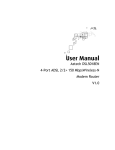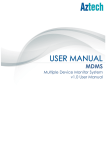Download Aztech GR7000 User manual
Transcript
GR7000 4-Port Wireless-N Gigabit Router User Manual Table of Contents About the Device........................................................................................................ 4 Minimum System Requirements ................................................................. 5 Package Contents ........................................................................................ 5 Device Overview.......................................................................................... 6 Front Panel ................................................................................................................6 Top Panel...................................................................................................................7 Back Panel.................................................................................................................7 Hardware Setup Diagram ........................................................................................... 8 Setup Your Device...................................................................................... 10 Changing the Wireless Settings ................................................................. 13 Changing the Wireless Security Settings ................................................... 14 WPS ........................................................................................................... 15 Viewing the Home Page............................................................................ 16 Configuring the LAN settings..................................................................... 18 Configuring Advanced WAN settings ......................................................... 19 Configuring Routing settings..................................................................... 21 Configuring Port Forwarding ..................................................................... 23 Configuring Filtering.................................................................................. 24 Configuring Dynamic DNS.......................................................................... 25 Configuring DMZ ........................................................................................ 26 Configuring Access Control ........................................................................ 27 Configuring Parental Control ..................................................................... 28 System Management ............................................................................................... 29 Accessing System Management ................................................................ 29 What’s on System Management................................................................ 29 Information .............................................................................................................30 Settings....................................................................................................................31 Firmware .................................................................................................................32 Reboot .....................................................................................................................33 Password .................................................................................................................34 Page 2 of 47 User Manual Network Tools .......................................................................................................... 35 Accessing Network Tools ........................................................................... 35 What’s on Network Tools........................................................................... 35 System Log..............................................................................................................36 Statistics ..................................................................................................................37 Diagnostic Tools ......................................................................................................38 Network Tools .........................................................................................................39 USB Storage Setup ..................................................................................... 40 USB Printer Setup ...................................................................................... 41 Page 3 of 47 User Manual About the Device Aztech GR7000 is a 4-Port Wireless-N Gigabit Router, which supports wireless 802.11b/g/n, 4-port Gigabit Ethernet switch, 1 Gigabit Ethernet WAN port for fiber ONT, and USB 2.0 Host. Targeted at providing good quality and high definition IPTV service to end users, Aztech GR7000 4 Port Wireless-N Gigabit Router is an intelligent 4-Port 10/100/1000 AutoMDI/MDIx managed switch. The 4 10/100/1000 Gigabit Ethernet ports connect network attached storage (NAS), computers, printers and other Ethernet enabled devices to enjoy higher throughput speed than that provided by the router with fast Ethernet wired ports. Aztech GR7000 supports the IEEE 802.11n ratified specifications, which is much faster than a wireless G router. The wireless-N technology allows more users to enjoy heavy Internet use and still deliver smooth performance for HD video streaming, music, photos, online gaming and large documents sharing. Security is provided via a double SPI (Stateful Packet Inspection) and Full Cone NAT support firewall. Hardware accelerated AES/WEP/WPA/WPA2 based encryption/MAC Address Filtering for Wireless links. Multiple session VPN Passthrough and DMZ support provide additional security support for telecommuters as well as allow flexibility while maintaining security against malicious hackers. Choices of Dynamic DNS servers give users the flexibility of hosting a web or FTP server with various domain names. The device comes with 2 USB ports allowing you to connect USB storage device or USB printer to share files and network printing with your family, friends, and colleagues. Page 4 of 47 User Manual Minimum System Requirements Your computer must meet the following minimum requirements. Any operating system can be used Web Browser CDROM drive 233MHz processor Ethernet network adapter An active Internet account Package Contents Package contents are listed below. For any missing items, please contact your dealer immediately. Product contents may vary for different models. GR7000 Ethernet cable 12V 1.5A DC Power Adapter Easy Start Guide Resource CD Page 5 of 47 User Manual Device Overview Front Panel LABEL POWER WAN ETHERNET LAN USB HOST WIRELESS INTERNET WPS Page 6 of 47 STATE On – Solid Green On – Solid Red Off On – Solid Green On – Blinking Green Off On – Solid Green On – Blinking Green Off On – Solid Green On – Blinking Green Off On – Solid Green On – Blinking Green Off On – Solid Green On – Blinking Green On – Red Off On – Solid Green On – Blinking Green Off DESCRIPTION Device is powered ON Device failure Device is powered OFF WAN port is connected Indicates WAN activity WAN port is not connected Ethernet device is connected Indicates LAN activity No Ethernet device connected USB device is connected Indicates USB activity No USB device connected Wireless interface is UP Indicates wireless activity Wireless interface is DOWN Internet connection is UP Indicates Internet activity PPPoE authentication failed Internet connection is DOWN WPS association is successful WPS authentication on going WPS disabled User Manual Top Panel Back Panel LABEL DESCRIPTION RESET Press the Reset button for 5 seconds to restore the device to default factory settings DC IN Connect to a 12V DC Power Adapter USB PORT 1 Connect to a USB storage device or USB printer USB PORT 2 Connect to a USB storage device or USB printer ETHERNET LAN 1-4 Connect to computers/Ethernet devices ETHERNET WAN Connect to a Cable/ADSL modem or ONT Page 7 of 47 User Manual Hardware Setup Diagram Before moving ahead to setup your network, it is a good idea to draw out a network diagram to help identify your network devices and plan out how to connect these devices. The illustration below is an example of a network diagram. Page 8 of 47 User Manual Each port in the router can be used for different connections. For example: 1. WAN Port – Connect to DSL/Cable modem or ONT for FTTH connection 2. Ethernet Port 1 – Wired PC 3. Ethernet Port 3 – Wired PC 4. USB Port 1 – External USB HDD 5. USB Port 2 – USB Printer 6. DC-in Port – Power Adapter 7. Wireless – Connect any wireless-enabled PCs and peripherals To create a network diagram: • For wireless devices, identify the wireless devices you want to include in the network • For wired devices, identify which router port you want to use for each device. Page 9 of 47 User Manual Setup Your Device You can use the Web Interface to setup your router for the first time. To Setup the router via the Web GUI: 1. Open your browser 2. Type 192.168.2.1 on the address bar 3. Input admin for both username and password fields and click on the Login button 4. On the top pane, click on Quick Setup Page 10 of 47 User Manual 5. Select the Time Zone according to your geographical location and then choose your preferred timeserver from the respective drop down list. 6. Select the Internet connection type from the drop-down list *Select DHCP to obtain an IP address from your broadband modem automatically. (For most cable modem users) *Select PPPoE if your ISP requires a PPP username and password for authentication. (For most ADSL modem users) *Select Static if your ISP provides all the IP information to you. You need to specify the IP address, Subnet mask, Default Gateway, Primary DNS and Secondary DNS (optional) on each field to configure your connection to the Internet. 7. By default, the Wireless interface is Enabled. If you wish to disable it, you can simply uncheck the Wireless Status check box. Page 11 of 47 User Manual 8. Each GR7000 is pre-assigned with a unique Wireless Network Name or SSID. You may change this SSID to your own preference. 9. Make sure to check the WPA Enabled check box to secure your Wireless Network from unauthorized access. 10. The default passphrase is set aabbccddee. You may change this to your own preference. Keep in mind that a WPA passphrase must have at least 8 characters in length. 11. For added security, you may hide the SSID by un-checking the Broadcast SSID check box. Please take note that if you hide the SSID, you will not be able to scan your wireless network, thus you need to add it manually to all the computers you want to connect to the GR7000 wirelessly. 12. Page 12 of 47 Click the Apply button to commit the changes User Manual Changing the Wireless Settings Modify the default Wireless Settings to suit your own preference. To change the Wireless settings via the Web GUI: 1. Open your browser 2. Type 192.168.2.1 on the address bar 3. Input admin for both username and password fields and click on Login 4. On the top pane, click Advanced Mode to show the advanced menu 5. Click the Wireless button, you can change the advanced wireless settings as desired from this page 6. Click Apply to commit the changes 7. Ensure to recreate the wireless profile on your computer to match the new settings Page 13 of 47 User Manual Changing the Wireless Security Settings Modify the default Wireless Security Settings to suit your own preference. To change the Wireless security settings via the Web GUI: 1. Open your browser 2. Type 192.168.2.1 on the address bar 3. Input admin for both username and password fields and click on Login 4. On the top pane, click Advanced Mode to show the advanced menu 5. Click the Wireless button, and click the Security menu. You can change the wireless security settings as desired from this page 6. Click Apply to commit the changes 7. Ensure to recreate the wireless profile on your computer to match the new settings Page 14 of 47 User Manual WPS WPS or Wifi Protected Setup makes it easy for wireless clients/devices to connect to the wireless router. Simply press the WPS button on the router and press the WPS button on the wireless client/device within 2 minutes, and the wireless security authentication will be done automatically. Page 15 of 47 User Manual Viewing the Home Page The Home Page will tell you information about your router. To view the Home Page via the Web GUI: 1. Open your browser 2. Type 192.168.2.1 on the address bar 3. Input admin for both username and password fields and click on Login 4. Internet Connection will display information about your current WAN connection. 5. LAN Connection will display the current MAC address of your LAN interface, as well as the IP address and subnet mask. 6. Wireless Connection will display the current wireless configuration. Page 16 of 47 User Manual 7. Local Network will display information about host computers currently connected to the router. 8. Storage will display any USB storage device connected to the USB port of the router. 9. Printer will display any USB printer device connected to the USB port of the router. Page 17 of 47 User Manual Configuring the LAN settings Setup the LAN configuration of your router from this page. To configure the LAN settings via the Web GUI: 1. Open your browser 2. Type 192.168.2.1 on the address bar 3. Input admin for both username and password fields and click on login 4. On the top pane, click Advanced Mode to expand the menu and click Network > Local 5. Enter the LAN parameters according to your preference 6. Click the Apply button to commit the changes Page 18 of 47 User Manual Configuring Advanced WAN settings Setup the Advanced WAN configuration of your router from this page. To configure the Advanced WAN settings via the Web GUI: 1. Open your browser 2. Type 192.168.2.1 on the address bar 3. Input admin for both username and password fields and click on Login 4. On the top pane, click Advanced Mode to expand the menu and click Network > Internet 5. Enter the WAN parameters according to your preference *Select DHCP to obtain an IP address from your broadband modem automatically. (For most cable modem users) Page 19 of 47 User Manual *Select PPPoE if your ISP requires a PPP username and password for authentication. (For most ADSL modem users) *Select Static if your ISP provides all the IP information to you. You need to specify the IP address, Subnet mask, Default Gateway, Primary DNS and Secondary DNS (optional) on each field to configure your connection to the Internet. 6. Click the Apply button to commit the changes Page 20 of 47 User Manual Configuring Routing settings If your LAN consists of multiple subnets and you want to manually define the data transmitting paths, Static Route is to be used. To configure the routing settings via the Web GUI: 1. Open your browser 2. Type 192.168.2.1 on the address bar 3. Input admin for both username and password fields and click on Login 4. On the top pane, click Advanced Mode to expand the menu and click Network > Routing 5. Enter the routing parameters according to your preference 6. Click the Apply button to commit the changes Page 21 of 47 User Manual The key settings for adding a new Static Route are explained: Destination IP Address Enter the network address to which the data packets are to be sent. Network Mask Enter the subnet mask for this destination. Gateway If you wish to use a specific gateway to reach the destination network, select this checkbox and then enter the IP address of the gateway. Interface If you wish to use a particular WAN interface, select the checkbox and select the interface. Click Apply to take effect the settings. To delete the entry from the routing table list, click its corresponding Delete button. Page 22 of 47 User Manual Configuring Port Forwarding Setup port-forwarding option to direct incoming traffic from the Internet to a specific computer in your local network. As an example, to setup a web server on a computer using 192.168.2.100 as its IP Address, select HTTP as Service and enter 192.168.2.100 as the Device IP Address. Otherwise if the service you want to setup is not available from the Application drop-down list, you can define your own Port Forwarding rule. To configure port forwarding via the Web GUI: 1. Open your browser 2. Type 192.168.2.1 on the address bar 3. Input admin for both username and password fields and click on Login 4. On the top pane, click Advanced Mode to expand the menu and click Applications > Port Forwarding 5. Enter the port forwarding parameters according to your preference 6. Click the Add Rule button to commit the changes Page 23 of 47 User Manual Configuring Filtering Setup filtering on your router from this page. To configure filtering via the Web GUI: 1. Open your browser 2. Type 192.168.2.1 on the address bar 3. Input admin for both username and password fields and click on Login 4. On the top pane, click Advanced Mode to expand the menu and click Applications > Filtering 5. Enter the filtering parameters according to your preference 6. Click the Add Rule button to commit the changes Page 24 of 47 User Manual Configuring Dynamic DNS The Router offers a Dynamic Domain Name System (DDNS) feature. DDNS lets you assign a fixed host and domain name to a dynamic Internet IP Address. It is useful when you are hosting your own website, FTP server, or other server behind the Router. Before using this feature, you need to sign up for DDNS service from a DDNS service provider. The Router supports popular Dynamic DNS service providers: (see DDNS page for list of supported DDNS service providers). To configure Dynamic DNS via the Web GUI: 1. Open your browser 2. Type 192.168.2.1 on the address bar 3. Input admin for both username and password fields and click on Login 4. On the top pane, click Advanced Mode to expand the menu and click Applications > Dynamic DNS 5. Enter the DDNS parameters according to your preference Page 25 of 47 User Manual 6. Click the Apply button to commit the changes Configuring DMZ Setup DMZ on your router from this page. To configure DMZ via the Web GUI: 1. Open your browser 2. Type 192.168.2.1 on the address bar 3. Input admin for both username and password fields and click on Login 4. On the top pane, click Advanced Mode to expand the menu and click Applications > DMZ 5. Put a check on the Enable tick box to enable DMZ feature 6. Enter the IP address of the host PC you want to setup as DMZ 7. Click the Apply button to commit the changes Page 26 of 47 User Manual Configuring Access Control Setup Access Control on your router from this page. To configure access control via the Web GUI: 1. Open your browser 2. Type 192.168.2.1 on the address bar 3. Input admin for both username and password fields and click on Login 4. On the top pane, click Advanced Mode to expand the menu and click Applications > Access Control 5. Put a check on the Server you wish to Enable 6. Specify the Port number that the server will use 7. Click the Apply button to commit the changes Page 27 of 47 User Manual Configuring Parental Control Setup Parental Control on your router from this page. To configure access control via the Web GUI: 1. Open your browser 2. Type 192.168.2.1 on the address bar 3. Input admin for both username and password fields and click on Login 4. On the top pane, click Advanced Mode to expand the menu and click Applications > Parental Control 5. Choose the policy you wish to Enable from the drop down box 6. Key in the MAC address of the Host PC 7. Specify the schedule according to your preference 8. Click the Apply button to commit the changes Page 28 of 47 User Manual System Management The System Management menu is used for router settings administration. Accessing System Management To access the Web User Interface: 1. Open your browser. 2. Type-in 192.168.2.1 on the address bar and then press Enter. What’s on System Management System Management includes the following options: Information Settings Firmware Reboot Password Page 29 of 47 User Manual Information This page shows the router information. Below is the list of information shown in this menu. Firmware Version – Shows the current firmware version of the Router Build Date – Shows the firmware release date Serial Number – Shows the serial number of the Router LAN MAC Address – Shows router’s LAN interface MAC address Wireless MAC Address – Shows router’s wireless interface MAC address System Uptime – Shows how long the Router has been UP. Page 30 of 47 User Manual Settings Settings menu allows you to backup, restore, and factory reset the Router settings. Backup – Backup the current router settings to a file on your PC Restore – Restore a backup configuration file to the router Factory Default – Reset the router configuration to factory default Page 31 of 47 User Manual Firmware Firmware menu allows you to backup, restore, and factory reset the Router settings. Firmware Information – Shows the current firmware’s version and build date Firmware Upgrade – Load a new firmware upgrade file to the router Page 32 of 47 User Manual Reboot Reboot allows you to reboot the Router for new settings to take effect. Reboot – Allows you to reboot the router Page 33 of 47 User Manual Password Password menu allows you to change the Router’s password to access the Graphical User Interface (GUI). Password – Allows you to change the router’s password Page 34 of 47 User Manual Network Tools The Network Tools menu is used for troubleshooting the router. Accessing Network Tools To access the Web User Interface: 1. Open your browser. 2. Type-in 192.168.2.1 on the address bar and then press Enter. What’s on Network Tools System Management includes the following options: System Log Statistics Diagnostic Tools Network Tools Page 35 of 47 User Manual System Log System Log allows you to monitor the Router’s activities. The system log can show you if there is any error that occurred on your router. Filter Level – Controls how much information is captured by the System log Page 36 of 47 User Manual Statistics This page displays statistics for the Router’s different interfaces such as LAN, WAN and wireless. The statistics page can show you how much information has been transferred and received on each interface and whether there are any errors in communication. LAN Statistics – Shows statistics for the LAN interface WLAN Statistics – Shows statistics for the wireless interface WAN Statistics – Show statistics for the WAN interface Page 37 of 47 User Manual Diagnostic Tools Diagnostic tools will automatically check the Router’s different interfaces such as LAN, WAN and wireless. It will also check the Router’s connectivity to the Internet. WAN Status – Shows the current status of the WAN interface LAN Status – Shows the current status of the LAN interface including the wireless interface Internet Connectivity – Shows the current status of the Router’s connectivity to the Internet LAN Connectivity – Shows the current status of the LAN connectivity Page 38 of 47 User Manual Network Tools Network tools provide utilities such as Ping and Trace Route to check the Router’s connectivity to the LAN and Internet. Ping – Sends a ping message to a specified IP address or URL to check for connectivity Traceroute – Determines the network route of the router’s communication to a specified IP address or URL. Page 39 of 47 User Manual USB Storage Setup You may connect a USB storage device to the router’s USB port to share the drive to all the host computers connected to the router. To configure USB storage via the Web GUI: 1. Open your browser 2. Type 192.168.2.1 on the address bar 3. Input admin for both username and password fields and click on Login 4. Connect the USB storage device to any one of the USB ports at the back panel of the router 5. The router will automatically configure the storage device 6. Check the Home page for the USB storage status Page 40 of 47 User Manual USB Printer Setup You may connect a USB printer to the router’s USB port to share the printer to all the host computers connected to the router. To configure USB printer via the Web GUI: 1. Open your browser 2. Type 192.168.2.1 on the address bar 3. Input admin for both username and password fields and click on Login 4. Connect the USB storage device to any one of the USB ports at the back panel of the router 5. The router will automatically configure the printer device 6. Check the Home page for the USB Printer status 7. After the Printer is detected successfully by the router, perform the following steps to add the printer to your computer 8. Install the printer driver on your computer 9. Once the printer driver is installed, you need to add the printer from the control panel 10. To add the printer, click on Start > Control Panel > Printers and Faxes 11. Double click on Add Printer Page 41 of 47 User Manual 12. Click on Next 13. Click to select Local printer attached to this computer. Make sure that Automatically detect and install my Plug and Play printer NOT checked 14. Click on Next Page 42 of 47 User Manual 15. Click to select Create a new port 16. Choose Standard TCP/IP Port from the drop down menu 17. Click on Next 18. Type the router’s IP address. Port name should be automatically filled up Page 43 of 47 User Manual 19. Click on Next 20. Click to select Custom Page 44 of 47 User Manual 21. Click on Next 22. Click Finish Page 45 of 47 User Manual Safety Precautions Do not open, service, or change any component. Only qualified technical specialists are allowed to service the equipment. Observe safety precautions to avoid electric shock Check voltage before connecting to the power supply. Connecting to the wrong voltage will damage the equipment. Page 46 of 47 User Manual © Copyright 2010 All rights reserved. No part of this document may be reproduced, republished, or retransmitted in any form or by any means whatsoever, whether electronically or mechanically, including, but not limited to, by way of photocopying, recording, information recording, or through retrieval systems without the express written permission. We reserve the right to revise this document at any time without the obligation to notify any person and/or entity. All other company or product names mentioned are used for identification purposes only and may be trademarks of their respective owners. LIMITATION OF LIABILITY AND DAMAGES THE PRODUCT AND THE SOFTWARES WITHIN ARE PROVIDED "AS IS," BASIS. THE MANUFACTURER AND MANUFACTURER’S RESELLERS (COLLECTIVELY REFERRED TO AS “THE SELLERS”) DISCLAIM ALL WARRANTIES, EXPRESS, IMPLIED OR STATUTORY, INCLUDING WITHOUT LIMITATION THE IMPLIED WARRANTIES OF NONINFRINGEMENT, MERCHANTABILITY OR FITNESS FOR A PARTICULAR PURPOSE, OR ANY WARRANTIES ARISING FROM COURSE OF DEALING, COURSE OF PERFORMANCE, OR USAGE OF TRADE. IN NO EVENT WILL THE SELLERS BE LIABLE FOR DAMAGES OR LOSS, INCLUDING BUT NOT LIMITED TO DIRECT, INDIRECT, SPECIAL WILLFUL, PUNITIVE, INCIDENTAL, EXEMPLARY, OR CONSEQUENTIAL, DAMAGES, DAMAGES FOR LOSS OF BUSINESS PROFITS, OR DAMAGES FOR LOSS OF BUSINESS OF ANY CUSTOMER OR ANY THIRD PARTY ARISING OUT OF THE USE OR THE INABILITY TO USE THE PRODUCT OR THE SOFTWARES, INCLUDING BUT NOT LIMITED TO THOSE RESULTING FROM DEFECTS IN THE PRODUCT OR SOFTWARE OR DOCUMENTATION, OR LOSS OR INACCURACY OF DATA OF ANY KIND, WHETHER BASED ON CONTRACT, TORT OR ANY OTHER LEGAL THEORY, EVEN IF THE PARTIES HAVE BEEN ADVISED OF THE POSSIBILITY OF SUCH DAMAGES. THE ENTIRE RISK AS TO THE RESULTS AND PERFORMANCE OF THE PRODUCT OR ITS SOFTWARE IS ASSUMED BY CUSTOMER. BECAUSE SOME STATES DO NOT ALLOW THE EXCLUSION OR LIMITATION OF LIABLITY FOR DAMAGES, THE ABOVE LIMITATION MAY NOT APPLY TO THE PARTIES. IN NO EVENT WILL THE SELLERS’ TOTAL CUMULATIVE LIABILITY OF EACH AND EVERY KIND IN RELATION TO THE PRODUCT OR ITS SOFTWARE EXCEED THE AMOUNT PAID BY CUSTOMER FOR THE PRODUCT. Page 47 of 47
























































